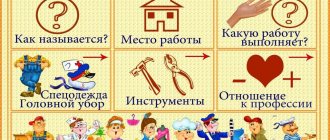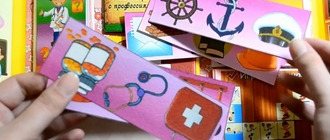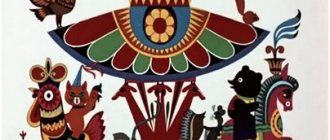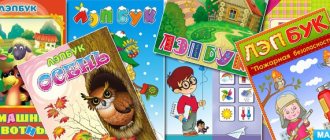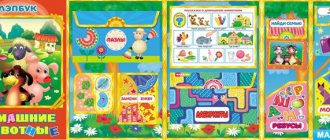All kinds of professions are important for people: teacher, accountant, hairdresser, cook, builder, fireman, driver, engineer, veterinarian salesman - they all benefit humanity, and without them it would be very difficult for us.
Already in childhood, children know exactly what they want to become in the future. They imagine themselves as astronauts, pilots, and dream of a beautiful and necessary business in their life. Subsequently, this passion passes, and the child can choose a completely different profession. But it is very important for children to know what its representatives do and what difficulties they will encounter.
Pictures for children will help tell children about professions.
Who develops the manual
The author of a lapbook is usually a teacher. But if for younger preschool age the teacher is involved in both the selection of material and its design, then in the middle group parents can get involved in the design and search for information.
For example, in my practice, as part of the discussion of the topic “Professions,” I give students and their parents a project task to write a story about the professions that we cannot do without. Or compile a manual with pictures, riddles, games dedicated to one profession.
In older preschool age, children take an active part in the selection of materials for designing a lapbook: they find illustrations, cut them out, and glue them. As in the middle group, mothers and fathers are actively involved in the search for materials, for example, they compose crosswords, puzzles on the topic, or collect a “data bank” about the professions of the future (city farmer engaged in landscaping megalopolises, developer of home robots, etc.).
Parents and children can offer materials for a group lapbook, and the teacher selects the most suitable and necessary information on the topic
Presentation “Types and forms of work activity in kindergarten”
Brief description of the document:
The work of children in kindergarten is varied. This allows them to maintain their interest in activities and provide them with comprehensive education and upbringing.
There are four main types of child labor: self-care, domestic labor, outdoor labor and manual labor. Self-care is aimed at caring for oneself (washing, undressing, dressing, making the bed, preparing the workplace, etc.). The educational significance of this type of work activity lies primarily in its vital necessity. Due to the daily repetition of actions, self-service skills are firmly acquired by children; self-care begins to be recognized as a responsibility.
In early preschool age, self-care is associated with certain difficulties (insufficient development of finger muscles, difficulty in mastering a sequence of actions, inability to plan them, easy distractibility), which slows down the process of skill formation and sometimes makes the child unwilling to perform the necessary actions. However, already in these children, the teacher begins to develop the ability to serve themselves, achieving accuracy and thoroughness in performing the necessary actions, independence, and forms the habit of cleanliness and tidiness. All this requires patience, perseverance and goodwill from him, supporting the kids in their sometimes futile efforts. When guiding children’s self-care, the teacher communicates individually with each child, establishes various contacts with him, and maintains his positive emotional state. By naming items of clothing and its parts, necessary actions, he expands the children's vocabulary. They feel cared for and imbued with a sense of love and trust in the adults serving them.
Household work is aimed at serving the team and therefore contains great opportunities for developing a caring attitude towards peers. In early preschool age, the teacher develops basic household skills in children: helping to set the table, tidying up toys after playing and washing them, collecting leaves on the site, sweeping snow from benches, etc. He necessarily evaluates the moral side of labor participation children: “Natasha and Seryozha helped our nanny well, what great guys!”, “Irochka is a caring girl, neat, how diligently she put away her toys!” Such assessments make children want to imitate their peers and contribute to the formation of ideas about how to act in such cases.
In younger groups, children, with the help of adults, water and wash indoor plants, plant bulbs, sow large seeds, take part in harvesting from their garden, and feed wintering birds. Supervising the work of the children, the teacher names the plants, their parts, and the actions performed in the work; this expands children's vocabulary and activates it.
In middle preschool age, children are quite independent in self-care, and this type of work becomes their constant responsibility. The complication of educational tasks is expressed in increased requirements for the quality of actions, for organized behavior in the process of self-care, and for the time spent on this. The teacher develops techniques for mutual assistance in children, teaches them how to ask a friend for help, how to provide it, and thank them for the service.
Household work of preschoolers is necessary in the daily life of a kindergarten, although its results are not so noticeable in comparison with other types of their labor activity. This work is aimed at maintaining cleanliness and order in the premises and area, and at helping adults organize routine processes. Children learn to notice any disturbance of order in a group room or area and, on their own initiative, eliminate it. In the middle group, the content of household work expands significantly: children fully set the table, prepare everything necessary for classes, wash doll clothes, wipe dust off shelves, sweep paths in the area, etc.
Using their increased capabilities and taking into account the developed skills, the teacher accustoms children to the fact that in work it is necessary to make an effort, develops independence, active initiative in carrying out assigned tasks. Labor in nature involves the participation of children in caring for plants and animals, growing plants in a corner of nature, in a vegetable garden, in a flower garden. This type of work is of particular importance for the development of observation, nurturing a caring attitude towards all living things, and love for one’s native nature. It helps the teacher solve the problems of children’s physical development, improving movements, increasing endurance, and developing the ability for physical effort.
In the middle group, work becomes more difficult . Children water the plants themselves, learn to determine the need for moisture, grow vegetables (sow seeds, water the beds, harvest), and with the help of the teacher prepare food for animals (squirrels, hamsters, rabbits, chickens). The teacher explains what food a particular animal needs, what it is called and how to store it. The process of caring for animals is closely connected with observations of them. Children begin to realize the dependence of the growth and development of plants and animal behavior on the quality of care, and their responsibility for them. There is growing concern and attention to the inhabitants of the living corner, who become children's favorites.
In older preschool age
new self-care skills are acquired: making the bed, caring for hair and shoes. The processes associated with it are used to solve more complex educational problems: developing in children the habit of neatness and cleanliness, and behavioral skills when surrounded by peers. The child serves himself while being around others, and therefore he must understand the needs and difficulties of others. The teacher, using specific examples, explains what to do, taking into account the needs of others: step aside in the dressing room to allow someone who has already undressed to pass; when washing, let those on duty go ahead (it is more important for them to wash as quickly as possible in order to begin their duties), do not linger at the tap so that everyone washes on time, ask permission to pass so as not to cause inconvenience to anyone, etc. All this shapes children basic courtesy and respect for others.
In the older groups of the kindergarten, household work is even more enriched in content and becomes systematic, largely turning into the permanent duties of those on duty. Children keep the room and area clean, repair toys and books, and provide assistance to children. The peculiarity of the household work of older preschoolers is the ability to organize it independently: select the necessary equipment, place it conveniently, put everything in order after work. In the process of work, children show diligence, a desire for a good result, and treat their peers kindly.
For the older group, plants that require more complex care techniques are placed in a corner of nature; various types of vegetables with different growing seasons are planted in the garden, which makes the work more systematic.
The volume of child labor is also increasing. Preschoolers spray plants with a spray bottle, sweep away dust from fuzzy leaves with a brush, and loosen the ground. With the help of the teacher, children feed the plants, dig up the soil in the vegetable garden and flower garden, plant seedlings, and collect seeds of wild plants (to feed wintering birds). In the process of work, the teacher teaches children to observe the growth and development of plants, to note changes that occur, to distinguish plants by their characteristic features, leaves, and seeds. This expands their understanding of plant life and arouses keen interest in them.
In the preparatory group , in the process of working in nature, children learn to establish connections between individual phenomena and discover patterns. The beginnings of a materialistic understanding of natural phenomena are being formed. Information about plants and care techniques is expanding. Children’s independence in work matters increases: without being reminded, they determine the need for watering and loosening the soil, replanting plants, sowing seeds in the garden, in the flower garden, and in winter - in a corner of nature where onions and other greens are constantly grown. Children will learn techniques for propagating plants by cuttings, growing seedlings and then replanting them in the ground.
Children become more responsible for the condition of the living area, vegetable garden and flower garden. Harvesting flowers gives them great joy. They give flowers to parents, treat the kids with grown vegetables, prepare vegetables for vinaigrette (wash them, peel them, take them to the kitchen), and decorate the group room with flowers.
Manual labor - making objects from a variety of materials: cardboard, paper, wood, natural materials (cones, acorns, straw, bark, corn cobs, peach pits), waste material (reels, boxes) using fur, feathers, fabric scraps, etc. , p. - carried out in older groups of kindergarten. Children make the toys they need and attributes for games: boats, cars, baskets, houses, furniture, animals. Such crafts can be a pleasant gift for family and friends. This is of no small importance in moral education, teaching children to pay attention to others and to work hard in order to please them.
Manual labor develops children's constructive abilities, creativity, imagination, and invention. So, to make a funny fairy-tale man from natural material, the child selects a large acorn for the body, a cup from it for a skirt or hat, splits the acorn in half to make shoes, etc. Preschoolers look with interest at the natural material to choose a shape corresponding to the intended object: dragonfly wings are made from maple seeds, forester wings are made from a cone, etc. In the process of work, they get acquainted with the properties of various materials, methods of processing and joining them, and learn to use various tools. The production of intended objects always involves the application of force. The child needs to show persistence, patience, and accuracy in order for the object to be durable and have a neat, elegant appearance.
All this has a great educational impact on children, shaping their aesthetic feelings and moral and volitional qualities.
The work of preschool children in kindergarten is organized in three main forms: in the form of assignments, duties, and collective work activities.
Assignments are tasks that the teacher occasionally gives to one or more children, taking into account their age and individual characteristics, experience, as well as educational tasks. Instructions can be short-term or long-term, individual or general, simple (containing one simple specific action) or more complex, including a whole chain of sequential actions.
Carrying out work assignments helps children develop an interest in work and a sense of responsibility for the assigned task. The child must concentrate his attention, show strong will in order to complete the task and inform the teacher about the completion of the assignment.
In younger groups, the instructions are individual, specific and simple, containing one or two actions (lay out the spoons on the table, bring a watering can, remove the doll’s dress for washing, etc.). Such elementary tasks involve children in activities aimed at benefiting the team, in conditions where they are not yet able to organize work on their own.
The assignment gives the teacher the opportunity to individualize the methods of guiding children: to help one, to teach another, to provide support to another, to approve. As preschoolers gain experience in participating in completing assignments, the teacher complicates their content. So, in the middle group, he instructs the children to wash doll clothes, wash toys, sweep paths, and rake sand into a pile on their own. These tasks are more complex, because they contain not only several actions, but also elements of self-organization (prepare a place for work, determine its sequence, etc.).
The number of assignments in the middle group increases significantly, as the experience of children’s participation in work gradually increases and their skills become more durable. The teacher now has the opportunity to give instructions to several preschoolers at once, although each of them is assigned a specific task. Thus, several children are increasingly beginning to take part in work at the same time, which makes it possible to include them more often and more systematically in useful work.
Assignments become a means of forming a habit of work effort in children and prepare them for duty.
In the older group, individual assignments are organized in those types of work in which children have insufficiently developed skills, or when they are taught new skills. Individual instructions are also given to children who need additional training or particularly careful control, i.e., if necessary, individualize methods of influence.
Most of the assignments that already took place in the middle group become group assignments, uniting from 2 to 5-6 participants, i.e., they take on a collective character. The teacher instructs the children to work together to clean shelves with toys, glue boxes for educational games, wash building materials, etc. The children perform a common task for everyone, which forces them to independently distribute the work between the participants, complete it together, and clean up after work. This contributes to the formation of the principles of collectivism, teaches them to show attention to each other in the process of work, and to provide assistance in case of difficulties.
Considering that self-organization skills in children of the older group are not yet sufficiently developed, the teacher should pay great attention to explaining how to arrange equipment, place equipment, and distribute work among its participants. In a school preparatory group, when carrying out general assignments, children must demonstrate the necessary self-organization skills, and therefore the teacher is more demanding of them, moving from explanation to control and reminder.
Duty duty is a form of organizing children’s work, which requires the child to perform work aimed at serving the team. Children are alternately included in different types of duty, which ensures the systematicity of their participation in work. The appointment and change of duty officers occurs daily. Duties have great educational value. They put the child under conditions of obligatory fulfillment of certain tasks; they are needed for the team. This allows children to develop responsibility towards the team, caring, and an understanding of the necessity of their work for everyone.
Duties are being introduced gradually. In the younger group , in the process of running errands, children acquired the skills necessary to set the table and became more independent when doing work. This allows the middle group to introduce canteen duty at the beginning of the year. There is one person on duty at each table every day. The teacher teaches the child to maintain consistency in work, controls him, and comes to the rescue, taking into account his individual characteristics.
Evaluating the work of those on duty, he emphasizes their diligence, thoroughness in performing duties, care for their comrades, and assistance provided to adults.
In the second half of the year, duties are introduced to prepare for classes. The teacher appoints 2-3 people on duty (depending on the amount of work) and distributes the work between them, comes to their aid, teaches the children how to finish the job and put away used equipment.
In older groups, duty in a corner of nature is introduced. The duty officers change daily, each of the children systematically participates in all types of duty. As a rule, children are on duty together. When selecting duty officers, the growing friendships between children are taken into account and their desire to work with one of their peers is satisfied. If the skills of one of the attendants are more advanced, he is advised to be attentive to his comrade, to provide him with assistance, but not to deprive him of his independence, and not to express his dissatisfaction with his slowness or inability. The teacher teaches children to coordinate their actions, determine what needs to be done taking into account the actions of a friend, agree on who will do what part of the work, teaches self-control, time- and effort-saving work methods.
Thus, it is necessary to note the variety of types of child labor in preschool educational institutions: self-service, household labor, labor in nature and manual labor. The share of certain types of labor at different age stages is not the same. Each of them has certain capabilities for solving educational problems. This allows children to maintain interest in work and ensures their comprehensive development. The main forms of work activity of preschool children in kindergarten: assignments, duty and collective work activity. Managing children's work activities requires the teacher to know the specifics of the child's development and upbringing, as well as the ability to actively promote the acquisition of the necessary skills.
How the “Professions” lapbook is developed
There are no restrictions on the flight of creative thought when preparing a manual; there are only a number of subtleties identified experimentally:
- the manual must be strong, as it is intended for active use, which means it is better to choose plastic folders or hard cardboard (for example, from packaging household appliances) for the base;
- materials - cards, pictures - must be laminated or covered with tape;
- pockets for storing materials must be firmly attached to the base (with glue or double-sided tape);
- the contents of the lapbook can be organized with separate cards, folding books or a window with a retractable tape (for example, for the game “Tell me what you want to become” - the child moves the tape and an image of a particular profession appears in the window, which needs to be told about and commented on whether the child would like to become a specialist in this profile).
As for the content of the manual, it must comply with the program material on the topic “Professions”, as well as the requirements of the Federal State Educational Standard regarding the knowledge, skills and abilities that children of a particular age should possess.
Table: nuances of choosing the content of “Professions” lapbook blocks in different groups
| Material block | Why is it included in the manual? | Peculiarities of consideration in different groups |
| Informational | To familiarize yourself with the topic. The information block is the basis of the manual, on which the rest of the materials are focused (visualization, games, etc.) | In the first junior group, children get acquainted with professions, with the results of the work of specialists that they encounter in everyday life: a cook prepares food in kindergarten, a driver drives the bus on which mother goes to work, a doctor treats if they are sick. |
| In the second junior group, children expand their knowledge about a person’s occupation (teacher, hairdresser, accountant, etc.), and also consider the topic in the context of the professional occupations of their loved ones (“My mother is a teacher,” etc.). | ||
| In the middle group, children learn to correlate a profession with the tools and materials that are needed for specialists in this profile (a car for a driver, a pointer for a teacher, a white coat, medicines, a phonendoscope for a doctor, etc.). | ||
| In the senior group, children form a generalized concept of “profession”, expand their ideas about labor actions, about specialties that were, are and will be relevant in the world. | ||
| In the preparatory group, children generalize their existing knowledge, and also form primary ideas about the importance of choosing a profession in a person’s life, and get acquainted with the professions of the future. | ||
| Literary (stories, poems) | To form images of professions, instill respect for work. | Younger preschoolers can be introduced to the topic with the help of “Tales of Missing Professions,” which focuses on the importance of having specialists in each field, as well as by drawing on excerpts from K. Chukovsky’s work “Doctor Aibolit.” |
In the middle group, you can include the poem “What do you have” by S. Mikhalkov in a lapbook, building on its basis a conversation on the topic “Why the professions of our mothers and fathers are important”:
| ||
For older preschoolers, the selection can include:
| ||
| Puzzles | To consolidate and repeat material. | In early preschool age, it is better to select tasks with rhyming answers, since it is still difficult for children to work with the “classic” version of riddles. For middle and older students, this block includes riddles about things directly related to the profession. |
| Visual | To add aesthetics to the manual and better assimilation of the material. In addition, the manual includes cartoons on the topic. | In the younger group, the visual block includes pictures depicting representatives of different professions to illustrate the teacher’s stories; in the second youngest group, the kids themselves describe the pictures in 3-4 sentences. In the middle group, based on the pictures, children compose a generalized story about the profession in 4–5 sentences, and in the older groups they supplement the story with their opinion regarding a particular specialty, try to imagine how our life would change without this profession (in 6–8 sentences) . |
| Creative (coloring, sculpting) | To consolidate materials, develop creative abilities and expand cognitive interests. | In early preschool age, children work with pictures that do not have a lot of details. In the middle and senior groups, children paint specialists in the surroundings of their professional activities (a doctor examining a patient, a teacher in a lesson). Starting from the middle group, this block can include step-by-step instructions for modeling on topics related to professions. |
| Block with puzzles and crosswords | To work with this block, children need to have an understanding of letters and also be able to write, so it is used only in lapbooks for older preschoolers. For toddlers and middle preschool children, you can use “Find the Differences” pictures. |
Video: cartoon presentation of professions for younger preschoolers
Video: cartoon “In the world of professions” for preschoolers
How to study professions using cards with children
To begin with, choose the simplest and most common professions that a child can see in everyday life: driver, salesman, janitor, doctor, and so on. Show your child several of these cards, name them and tell them where he met them and what the representatives of this profession do. So the baby will quickly understand what we are talking about.
Then you can gradually add new cards to the study, tell them what professions are for, what benefits they bring to people. Be sure to remember, when walking or visiting public places, to show your child people of relevant professions and observe their actions.
Classes with the help of educational cards contribute to the development of the child’s vocabulary, horizons, observation and memory.
Good luck to your children in learning about the world around them!
You can learn professions with the help of educational cartoons Children's Corner
Profession pictures for children
Profession pictures for children
Profession pictures for children
Profession pictures for children
Profession pictures for children
Profession pictures for children
Profession pictures for children
Pictures of children's professions
Pictures of children's professions
Pictures of children's professions
Pictures of children's professions
Pictures of children's professions
Pictures of children's professions
Pictures of children's professions
Pictures of children's professions
Pictures of children's professions
Pictures of children's professions
Pictures of children's professions
Professions in pictures for children download
Professions in pictures for children download
Professions in pictures for children download
Professions in pictures for children download
Professions in pictures for children download
Professions in pictures for children download
Professions in pictures for children download
You can learn professions with the help of educational cartoons Children's Corner
A selection of materials for the laptop “Professions”
When choosing materials, the teacher is guided by the program, the Federal State Educational Standard and the level of development of children in a particular group.
Information block
As text to illustrate thematic pictures, you can use descriptions of modern professions (Teacher, Manager, Hairdresser, etc. and Accountant, Cook, Seller, etc.). And for older preschoolers, it is worth including information about the professions of the future in the lapbook.
To summarize professions by area of application, you can make a “Profession Country Map”, distributing specialties in several areas: “City of Services” (hairdresser, salesman, etc.), “City of Knowledge” (scientist, teacher, etc.), etc. Based on the description of each city, children lay out pictures depicting the corresponding specialists.
The guys write a separate story-description about each “city”
To facilitate the task of telling about a profession using a picture, children in the middle and older groups can be offered a visual plan.
A plan with illustrations helps to create a story about the profession even for those who cannot yet read
Poems
In a block with rhyming for younger preschoolers you can include:
- Give the cook the food: Poultry, dried fruits, Rice, potatoes... And then delicious food awaits you.
- In the morning the sun shines brightly, the milkmaid carries the milk. Warm, cow, good for children's health.
- Give me scissors and a comb, He will do your hair. The hairdresser will certainly give you a modern haircut.
- A hammer is needed for work, and a carpenter is friendly with a saw. He sawed the planks and made a birdhouse.
For middle and senior preschool age, a selection can be compiled based on materials from the collection published here.
Puzzles
Rhymes with “agreements” about professions are usually included in the manual for the middle group, but in a lapbook for kids it can be used in fragments.
For middle and older groups, the selection can also include riddles about tools:
- He sews everything in the world. What he sews, he doesn’t put on (Needle);
- I run along my bald head - I cut the curls from my bald head (Plane);
- A lot of friendly guys are sitting on one pillar. As they begin to frolic - Only dust swirls around (Broom).
Riddles dedicated to specific professions can be found here.
Proverbs, sayings
A lapbook for middle and older age should include proverbs and sayings about the importance of work:
- The craft does not hang behind your shoulders.
- The cook is always full of spirit.
- The cook lives better than the prince.
- It will be a disaster if the shoemaker starts baking pies.
- You won't get bread by self-indulgence.
- Not all chefs have long knives.
Game block
This block can include all types of games in the form of a brief description of the conditions or a selection of visual materials.
Table: examples of games for the “Professions” laptop
| What is the name of the game | The essence | Which age group is it aimed at? |
| Didactic games | ||
| "Clap your hands if..." |
| To the second youngest |
| "Correct the mistake" | The teacher says a phrase, and the children correct the mistake:
| To medium |
| "Continue the sentence" | The teacher begins the phrase, the children finish:
| For seniors |
| Theatrical | ||
| "Let's show how it is" | Children are offered a list of situations that they act out in skits:
| |
| “We won’t tell you where we were, but we’ll show you what we did.” |
| For middle, senior |
| Outdoor games | ||
| “All professions are important” (for the gym) | The teacher describes the profession, the children perform the following movements:
| For seniors |
| Examples of finger games on the topic “Professions” can be found in the publication of N.V. Kochetkova. | ||
Photo gallery: puzzles, crossword puzzles and “Find the Differences” themed pictures for the “Professions” lapbook
Answers: stylist, cook, steelworker, astronomer, miner, understudy, livestock breeder, journalist, gold miner, archer, spooner, crabber, mower, cattle breeder, crusader, carpenter, key holder, spy
By solving a crossword puzzle, children practice their knowledge of letters
Answer: postman
Children need to find 5 differences in pictures with fishermen
In these pictures the guys are looking for 5 differences
Children need to find 10 differences in these pictures.
Photo gallery: templates for coloring and instructions for modeling on the topic of profession
An additional task for the Chef's coloring book could be to come up with a story about what he cooks
Despite the number of small details, even kids can color the ballerina: filling with color is only necessary for the ballet tutu
The coloring book of a Builder with a fragment of a brick wall can be used already in the second junior group to practice accurate coloring of masonry rectangles
When considering the profession of a hairdresser, it is important to emphasize that both women and men can engage in this activity
When considering a topic related to a person’s professional development, it is worth paying attention to specialties that for many are a hobby, in particular photography
Based on the “Seamstress” coloring book, you can invite children from the preparatory group to reflect on the relevance of this profession in the future
Among the important professions that we cannot do without, we definitely need to pay attention to those that are related to saving people’s lives in extraordinary situations
When considering the topic “Professions of the Future”, it is necessary to mention the profession of a scientist
To add brightness to the image of the Artist, you can use wax crayons for coloring
In the older group, children can work with the modeling instructions on their own; no explanations from the teacher are needed.
What's the best way to tell it? (With examples)
- For example, let's talk about the profession of a doctor. A doctor is a very necessary profession. The doctor is dressed in a white coat and has a special cap on his head. This is a doctor's form. The doctor treats children and adults from diseases. The doctor works in the hospital. For his work, he needs special tools, such as a phonendoscope, syringe, thermometer, etc. The profession of a doctor is needed in order to protect and treat people from various diseases. With the help of these profession cards in pictures, your child will expand his horizons, learn a lot of new things, develop speech, especially important for 3 years old, and memory. You can download professions in pictures here completely free of charge - click on the image below to download for free:
- A seller, for example, sells goods in a store. This profession requires communication skills and accuracy. The seller must also be able to count well, and the child’s attention should be focused on this.
- An engineer is a complex technical profession that requires good knowledge of mathematics and technology. An engineer can find use in a factory when creating new technical developments.
- A driver is needed everywhere. This is not just a person who drives a taxi. Drivers are required at enterprises, at construction sites, for intercity cargo transportation, etc. This profession requires endurance, attention and, of course, the ability to drive a car.
- A veterinarian treats animals. He must have a medical education. And, of course, the veterinarian must love our little brothers.
- The cook loves to cook, but he does it according to culinary standards and requirements. A cook is needed not only in canteens or restaurants, but also in organizations, schools, and kindergartens.
- The builder participates in the construction of houses. This profession requires physical strength. Construction is a very necessary profession.
- The hairdresser does our hair. A hairdresser must have dexterous hands and a subtle artistic taste.
- An accountant calculates costs and profits at enterprises, firms, and organizations. An accountant must have an economic education and have mathematical abilities.
- A teacher is a rather difficult profession. It is necessary not only to be able to present the material in an interesting way, but also to organize the children’s work. The teacher must have moral restraint and tact, and know his subject well.
Pictures for children on our website will help children learn more about professions and feel what their future recognition will be. The main thing is to instill respect in children for any type of activity. Whoever it is - a fireman, a teacher, a doctor, a builder, a driver - the work of any person must be treated with care.
How to use a lapbook in kindergarten and at home
The manual is universal: it can be used in classes both in kindergarten and at home. Lapbook is convenient:
- to present new material on the topic;
- to practice acquired knowledge;
- for consolidation and repetition of material.
Based on the directions of use of the manual, we can conclude that an entire lesson can be built on its basis: update knowledge on the topic with poems, use knowledge in practice by solving riddles, playing, and consolidate the material covered by solving puzzles, solving crosswords and coloring.
Children can work with a lapbook both independently and in a group.
